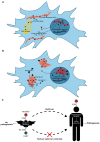Host-Pathogen Interactions Influencing Zoonotic Spillover Potential and Transmission in Humans
- PMID: 36992308
- PMCID: PMC10060007
- DOI: 10.3390/v15030599
Host-Pathogen Interactions Influencing Zoonotic Spillover Potential and Transmission in Humans
Abstract
Emerging infectious diseases of zoonotic origin are an ever-increasing public health risk and economic burden. The factors that determine if and when an animal virus is able to spill over into the human population with sufficient success to achieve ongoing transmission in humans are complex and dynamic. We are currently unable to fully predict which pathogens may appear in humans, where and with what impact. In this review, we highlight current knowledge of the key host-pathogen interactions known to influence zoonotic spillover potential and transmission in humans, with a particular focus on two important human viruses of zoonotic origin, the Nipah virus and the Ebola virus. Namely, key factors determining spillover potential include cellular and tissue tropism, as well as the virulence and pathogenic characteristics of the pathogen and the capacity of the pathogen to adapt and evolve within a novel host environment. We also detail our emerging understanding of the importance of steric hindrance of host cell factors by viral proteins using a "flytrap"-type mechanism of protein amyloidogenesis that could be crucial in developing future antiviral therapies against emerging pathogens. Finally, we discuss strategies to prepare for and to reduce the frequency of zoonotic spillover occurrences in order to minimize the risk of new outbreaks.
Keywords: Ebola virus; Mobillivirus; Nipah virus; innate immune antagonism factors; interhuman transmission; species barriers; viral amyloidogenesis; viral spillover; zoonosis.
Conflict of interest statement
The authors declare no conflict of interest. The funders had no role in the writing of the manuscript or in the decision to publish.
Figures



Similar articles
-
Host phylogenetic distance drives trends in virus virulence and transmissibility across the animal-human interface.Philos Trans R Soc Lond B Biol Sci. 2019 Sep 30;374(1782):20190296. doi: 10.1098/rstb.2019.0296. Epub 2019 Aug 12. Philos Trans R Soc Lond B Biol Sci. 2019. PMID: 31401961 Free PMC article.
-
Sialic Acid Receptors: The Key to Solving the Enigma of Zoonotic Virus Spillover.Viruses. 2021 Feb 8;13(2):262. doi: 10.3390/v13020262. Viruses. 2021. PMID: 33567791 Free PMC article. Review.
-
Spillover and pandemic properties of zoonotic viruses with high host plasticity.Sci Rep. 2015 Oct 7;5:14830. doi: 10.1038/srep14830. Sci Rep. 2015. PMID: 26445169 Free PMC article.
-
Pathways to zoonotic spillover.Nat Rev Microbiol. 2017 Aug;15(8):502-510. doi: 10.1038/nrmicro.2017.45. Epub 2017 May 30. Nat Rev Microbiol. 2017. PMID: 28555073 Free PMC article. Review.
-
Ranking the risk of animal-to-human spillover for newly discovered viruses.Proc Natl Acad Sci U S A. 2021 Apr 13;118(15):e2002324118. doi: 10.1073/pnas.2002324118. Proc Natl Acad Sci U S A. 2021. PMID: 33822740 Free PMC article.
Cited by
-
Zoonotic Paramyxoviruses: Evolution, Ecology, and Public Health Strategies in a Changing World.Viruses. 2024 Oct 29;16(11):1688. doi: 10.3390/v16111688. Viruses. 2024. Retraction in: Viruses. 2025 Jul 16;17(7):992. doi: 10.3390/v17070992. PMID: 39599803 Free PMC article. Retracted. Review.
-
Immune correlates of protection for SARS-CoV-2, Ebola and Nipah virus infection.Front Immunol. 2023 Apr 17;14:1156758. doi: 10.3389/fimmu.2023.1156758. eCollection 2023. Front Immunol. 2023. PMID: 37153606 Free PMC article. Review.
-
The impact of anthropogenic climate change on pediatric viral diseases.Pediatr Res. 2024 Jan;95(2):496-507. doi: 10.1038/s41390-023-02929-z. Epub 2023 Dec 6. Pediatr Res. 2024. PMID: 38057578 Free PMC article. Review.
-
A conserved motif in Henipavirus P/V/W proteins drives the fibrillation of the W protein from Hendra virus.Protein Sci. 2025 Apr;34(4):e70085. doi: 10.1002/pro.70085. Protein Sci. 2025. PMID: 40100133 Free PMC article.
-
PANoptosis Regulation in Reservoir Hosts of Zoonotic Viruses.Viruses. 2024 Nov 4;16(11):1733. doi: 10.3390/v16111733. Viruses. 2024. PMID: 39599847 Free PMC article. Review.
References
-
- Pandit P.S., Anthony S.J., Goldstein T., Olival K.J., Doyle M.M., Gardner N.R., Bird B., Smith W.A., Wolking D., Gilardi K., et al. Predicting the Potential for Zoonotic Transmission and Host Associations for Novel Viruses. Commun. Biol. 2022;5:844. doi: 10.1038/s42003-022-03797-9. - DOI - PMC - PubMed
Publication types
MeSH terms
LinkOut - more resources
Full Text Sources

